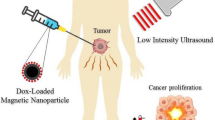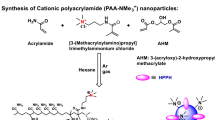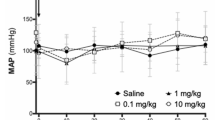Abstract
Ultrasound (US) is an effective tool for local delivery of genes into target tumors or organs. In combination with microbubbles, US can temporarily change the permeability of cell membranes by cavitation and facilitate entry of plasmid DNA into cells. Here, we demonstrate that repeated US-mediated delivery of anti-angiogenic genes, endostatin or calreticulin, into muscle significantly inhibits the growth of orthotopic tumors in the liver, brain or lung. US-mediated anti-angiogenic gene therapy also seems to function as an adjuvant therapy that significantly enhances the antitumor effects of the chemotherapeutic drug doxorubicin and adenovirus-mediated cytokine gene therapy. Significantly higher levels of tumor apoptosis or tumor-infiltrating lymphocytes were observed after combined therapy consisting of either anti-angiogenic therapy and chemotherapy, or anti-angiogenic therapy and immunotherapy. Taken together, our experiments demonstrate that intramuscular delivery of anti-angiogenic genes by US exposure can effectively treat distant orthotopic tumors, and thus has great therapeutic potential in terms of clinical treatment.
This is a preview of subscription content, access via your institution
Access options
Subscribe to this journal
Receive 12 print issues and online access
$259.00 per year
only $21.58 per issue
Buy this article
- Purchase on Springer Link
- Instant access to full article PDF
Prices may be subject to local taxes which are calculated during checkout






Similar content being viewed by others
References
Li YS, Davidson E, Reid CN, McHale AP . Optimising ultrasound-mediated gene transfer (sonoporation) in vitro and prolonged expression of a transgene in vivo: potential applications for gene therapy of cancer. Cancer Lett 2009; 273: 62–69.
Newman CM, Bettinger T . Gene therapy progress and prospects: ultrasound for gene transfer. Gene Ther 2007; 14: 465–475.
Tachibana K, Uchida T, Ogawa K, Yamashita N, Tamura K . Induction of cell-membrane porosity by ultrasound. Lancet 1999; 353: 1409.
Miller MW, Miller DL, Brayman AA . A review of in vitro bioeffects of inertial ultrasonic cavitation from a mechanistic perspective. Ultrasound Med Biol 1996; 22: 1131–1154.
Barnett SB, ter Haar GR, Ziskin MC, Nyborg WL, Maeda K, Bang J . Current status of research on biophysical effects of ultrasound. Ultrasound Med Biol 1994; 20: 205–218.
Shen ZP, Brayman AA, Chen L, Miao CH . Ultrasound with microbubbles enhances gene expression of plasmid DNA in the liver via intraportal delivery. Gene Ther 2008; 15: 1147–1155.
Lawrie A, Brisken AF, Francis SE, Cumberland DC, Crossman DC, Newman CM . Microbubble-enhanced ultrasound for vascular gene delivery. Gene Ther 2000; 7: 2023–2027.
Li T, Tachibana K, Kuroki M . Gene transfer with echo-enhanced contrast agents: comparison between Albunex, Optison, and Levovist in mice—initial results. Radiology 2003; 229: 423–428.
Bekeredjian R, Grayburn PA, Shohet RV . Use of ultrasound contrast agents for gene or drug delivery in cardiovascular medicine. J Am Coll Cardiol 2005; 45: 329–335.
Miller DL, Quddus J . Sonoporation of monolayer cells by diagnostic ultrasound activation of contrast-agent gas bodies. Ultrasound Med Biol 2000; 26: 661–667.
Hayashi S, Mizuno M, Yoshida J, Nakao A . Effect of sonoporation on cationic liposome-mediated IFNbeta gene therapy for metastatic hepatic tumors of murine colon cancer. Cancer Gene Ther 2009; 16: 638–643.
Bekeredjian R, Chen S, Frenkel PA, Grayburn PA, Shohet RV . Ultrasound-targeted microbubble destruction can repeatedly direct highly specific plasmid expression to the heart. Circulation 2003; 108: 1022–1026.
Taniyama Y, Tachibana K, Hiraoka K, Namba T, Yamasaki K, Hashiya N et al. Local delivery of plasmid DNA into rat carotid artery using ultrasound. Circulation 2002; 105: 1233–1239.
Koike H, Tomita N, Azuma H, Taniyama Y, Yamasaki K, Kunugiza Y et al. An efficient gene transfer method mediated by ultrasound and microbubbles into the kidney. J Gene Med 2005; 7: 108–116.
Miao CH, Brayman AA, Loeb KR, Ye P, Zhou L, Mourad P et al. Ultrasound enhances gene delivery of human factor IX plasmid. Hum Gene Ther 2005; 16: 893–905.
Lu QL, Liang HD, Partridge T, Blomley MJ . Microbubble ultrasound improves the efficiency of gene transduction in skeletal muscle in vivo with reduced tissue damage. Gene Ther 2003; 10: 396–405.
Wang X, Liang HD, Dong B, Lu QL, Blomley MJ . Gene transfer with microbubble ultrasound and plasmid DNA into skeletal muscle of mice: comparison between commercially available microbubble contrast agents. Radiology 2005; 237: 224–229.
Taniyama Y, Tachibana K, Hiraoka K, Aoki M, Yamamoto S, Matsumoto K et al. Development of safe and efficient novel nonviral gene transfer using ultrasound: enhancement of transfection efficiency of naked plasmid DNA in skeletal muscle. Gene Ther 2002; 9: 372–380.
Hauff P, Seemann S, Reszka R, Schultze-Mosgau M, Reinhardt M, Buzasi T et al. Evaluation of gas-filled microparticles and sonoporation as gene delivery system: feasibility study in rodent tumor models. Radiology 2005; 236: 572–578.
Manome Y, Nakamura M, Ohno T, Furuhata H . Ultrasound facilitates transduction of naked plasmid DNA into colon carcinoma cells in vitro and in vivo. Hum Gene Ther 2000; 11: 1521–1528.
Yamashita Y, Shimada M, Tachibana K, Harimoto N, Tsujita E, Shirabe K et al. In vivo gene transfer into muscle via electro-sonoporation. Hum Gene Ther 2002; 13: 2079–2084.
Ribatti D, Vacca A, Dammacco F . The role of the vascular phase in solid tumor growth: a historical review. Neoplasia 1999; 1: 293–302.
Carmeliet P . Angiogenesis in life, disease and medicine. Nature 2005; 438: 932–936.
Folkman J . Tumor angiogenesis: therapeutic implications. N Engl J Med 1971; 285: 1182–1186.
Duvshani-Eshet M, Benny O, Morgenstern A, Machluf M . Therapeutic ultrasound facilitates antiangiogenic gene delivery and inhibits prostate tumor growth. Mol Cancer Ther 2007; 6: 2371–2382.
Tsai KC, Liao ZK, Yang SJ, Lin WL, Shieh MJ, Hwang LH et al. Differences in gene expression between sonoporation in tumor and in muscle. J Gene Med 2009; 11: 933–940.
Tai KF, Chen PJ, Chen DS, Hwang LH . Concurrent delivery of GM-CSF and endostatin genes by a single adenoviral vector provides a synergistic effect on the treatment of orthotopic liver tumors. J Gene Med 2003; 5: 386–398.
Lee YL, Ye YL, Yu CI, Wu YL, Lai YL, Ku PH et al. Construction of single-chain interleukin-12 DNA plasmid to treat airway hyperresponsiveness in an animal model of asthma. Hum Gene Ther 2001; 12: 2065–2079.
Chang CJ, Chen YH, Huang KW, Cheng HW, Chan SF, Tai KF et al. Combined GM-CSF and IL-12 gene therapy synergistically suppresses the growth of orthotopic liver tumors. Hepatology 2007; 45: 746–754.
Huang KW, Huang YC, Tai KF, Chen BH, Lee PH, Hwang LH . Dual therapeutic effects of interferon-alpha gene therapy in a rat hepatocellular carcinoma model with liver cirrhosis. Mol Ther 2008; 16: 1681–1687.
Tseng SH, Chen Y, Chang CJ, Tai KF, Lin SM, Hwang LH . Induction of T-cell apoptosis in rats by genetically engineered glioma cells expressing granulocyte-macrophage colony-stimulating factor and B7.1. Clin Cancer Res 2005; 11: 1639–1649.
Chen HW, Lee JY, Huang JY, Wang CC, Chen WJ, Su SF et al. Curcumin inhibits lung cancer cell invasion and metastasis through the tumor suppressor HLJ1. Cancer Res 2008; 68: 7428–7438.
Kulke MH, Bergsland EK, Ryan DP, Enzinger PC, Lynch TJ, Zhu AX et al. Phase II study of recombinant human endostatin in patients with advanced neuroendocrine tumors. J Clin Oncol 2006; 24: 3555–3561.
Celik I, Surucu O, Dietz C, Heymach JV, Force J, Hoschele I et al. Therapeutic efficacy of endostatin exhibits a biphasic dose–response curve. Cancer Res 2005; 65: 11044–11050.
Cho HM, Rosenblatt JD, Kang YS, Iruela-Arispe ML, Morrison SL, Penichet ML et al. Enhanced inhibition of murine tumor and human breast tumor xenografts using targeted delivery of an antibody–endostatin fusion protein. Mol Cancer Ther 2005; 4: 956–967.
Hansma AH, Broxterman HJ, van der Horst I, Yuana Y, Boven E, Giaccone G et al. Recombinant human endostatin administered as a 28-day continuous intravenous infusion, followed by daily subcutaneous injections: a phase I and pharmacokinetic study in patients with advanced cancer. Ann Oncol 2005; 16: 1695–1701.
Thomas JP, Arzoomanian RZ, Alberti D, Marnocha R, Lee F, Friedl A et al. Phase I pharmacokinetic and pharmacodynamic study of recombinant human endostatin in patients with advanced solid tumors. J Clin Oncol 2003; 21: 223–231.
Jain RK . Normalization of tumor vasculature: an emerging concept in antiangiogenic therapy. Science 2005; 307: 58–62.
Huber PE, Bischof M, Jenne J, Heiland S, Peschke P, Saffrich R et al. Trimodal cancer treatment: beneficial effects of combined antiangiogenesis, radiation, and chemotherapy. Cancer Res 2005; 65: 3643–3655.
Tong RT, Boucher Y, Kozin SV, Winkler F, Hicklin DJ, Jain RK . Vascular normalization by vascular endothelial growth factor receptor 2 blockade induces a pressure gradient across the vasculature and improves drug penetration in tumors. Cancer Res 2004; 64: 3731–3736.
Ma J, Waxman DJ . Combination of antiangiogenesis with chemotherapy for more effective cancer treatment. Mol Cancer Ther 2008; 7: 3670–3684.
Huang KW, Wu HL, Lin HL, Liang PC, Chen PJ, Chen SH et al. Combining antiangiogenic therapy with immunotherapy exerts better therapeutical effects on large tumors in a woodchuck hepatoma model. Proc Natl Acad Sci USA 2010; 107: 14769–14774.
Acknowledgements
This work was supported by Grant NSC 99-2320-B-002-005-MY3 to W-SC from the National Science Council of the Republic of China, and in part by a grant from the Ministry of Education, Aim for the Top University Plan to L-HH.
Author information
Authors and Affiliations
Corresponding authors
Ethics declarations
Competing interests
The authors declare no conflict of interest.
Additional information
Supplementary Information accompanies the paper on Cancer Gene Therapy website
Rights and permissions
About this article
Cite this article
Liao, ZK., Tsai, KC., Wang, HT. et al. Sonoporation-mediated anti-angiogenic gene transfer into muscle effectively regresses distant orthotopic tumors. Cancer Gene Ther 19, 171–180 (2012). https://doi.org/10.1038/cgt.2011.73
Received:
Revised:
Accepted:
Published:
Issue Date:
DOI: https://doi.org/10.1038/cgt.2011.73
Keywords
This article is cited by
-
Ultrasound-targeted microbubble destruction remodels tumour microenvironment to improve immunotherapeutic effect
British Journal of Cancer (2023)
-
Ultrasound Enhanced PEI-Mediated Gene Delivery Through Increasing the Intracellular Calcium Level and PKC-δ Protein Expression
Pharmaceutical Research (2014)
-
Optimization of Ultrasound-mediated Anti-angiogenic Cancer Gene Therapy
Molecular Therapy - Nucleic Acids (2013)



